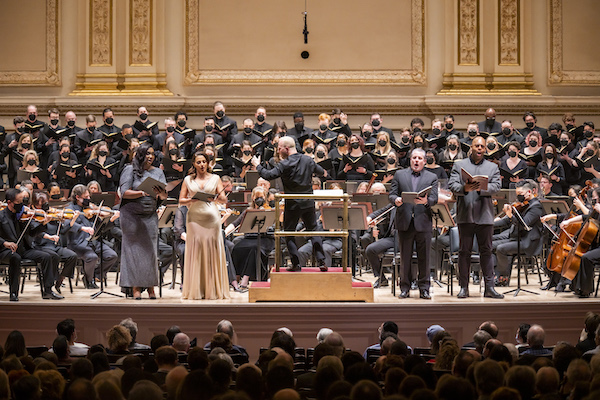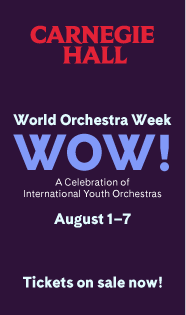Philadelphia Orchestra wraps Beethoven cycle with playful First, elevated Ninth

Yannick Nézet-Séguin and the Philadelphia Orchestra ended its full cycle of Beethoven symphonies at Carnegie Hall to cheers. It came as no surprise that the audience instantly jumped to its feet as the last notes of Beethoven’s Ninth Symphony sounded. The world is in a difficult place at the moment and the triumphant conclusion of Beethoven’s final symphony offers something in short supply these days—hope—for which they are thirsting.
The concert began with Beethoven’s First Symphony and ended with his final one. Composed between 1799 and 1800, the First finds Beethoven at his most optimistic and confident. Within a year or two, he began to experience the first symptoms of the hearing loss that would have a profound impact not only on him as a person, but also take music in directions that the audiences and critics who so enthusiastically embraced the 29-year-old composer’s first stab at a symphony could never have imagined.
Nézet-Séguin offered a playful, lighthearted account of the symphony, encouraging a musical dialogue between sections whenever the opportunity arose. In this performance the emphasis was on clarity and balance, in many ways approximating what Beethoven’s contemporaries might have experienced when they first heard the work.
Gabriela Lena Frank has a unique musical voice derived from her rich ethnic mix. Her father, who is of Lithuanian-Jewish heritage, was born in the United States, and her mother is Peruvian, of Chinese and indigenous indio descent. Frank draws on her multicultural background to infuse her music with brilliant colors, enticing melodies and exciting rhythms. Frank was also born with a severe hearing loss, as well as perfect pitch. The parallels with Beethoven, at least in this regard, are obvious and she does not shy from discussing them.
Currently, composer-in-residence with the Philadelphia Orchestra, Frank was commissioned to compose a work for the commemoration of the 250th anniversary of Beethoven’s birth in 2020 that would serve as a response to his First and Ninth. The result was Pachamama Meets an Ode, a work for chorus and orchestra for which she wrote the text, that received its belated world premiere Monday night. This is the first piece in which Frank addresses climate change, but certainly not the last according to her.
In Pachamama Meets an Ode, Frank crafts a dialogue between Beethoven and an indigenous artist painting religious pictures in a church built on the ruins of an Incan temple. In her text, Frank explores what she sees as inherent contradictions between the ideals of the European Enlightenment, as embodied in Beethoven’s Ninth, and the simultaneous push to industrialization and exploitation of natural resources that planted the seeds of the human race’s devastating impact on the environment. The text ends with Pachamama, an Earth Mother deity worshiped by the indigenous peoples of the Andes posing the questions, “What of odes? What of joy?”
A condition of the commission was that Frank compose for the same musical forces which Beethoven had on hand, so she wrote for the massive orchestra and chorus employed in the Ninth. The result was a work that contrasted the grace and elegance of a Classical orchestra with the brilliant, more colorful sounds of South America. It is a text-driven piece, however, and the masked Philadelphia Symphonic Choir struggled, failing to clearly deliver the text or the volume of sound required.
In contrast to his brisk, bright reading of the First, Nézet-Séguin imposed a contemplative mood on the Ninth. That is not to say that the performance lacked vitality and excitement, but clearly Nézet-Séguin was intent of probing the depths of emotion with which Beethoven imbued the work.
Amidst all of the glorious sound, there were two unforgettable moments in this performance of the Ninth. The first was the astonishingly beautiful liquid tone by Ernesto Tovar Torres’s horn solo in the third movement and the other was Ryan Speedo Green stilling the musical chaos in the Finale with his majestic bass-baritone. It wasn’t so much Green’s heroic presence or the size of his voice that was so impressive, but the freedom and ease with which he sang.
Green was a hard act to follow yet tenor Matthew Polenzani was in fine voice, his gleaming tenor slicing through the air in a spirited account of the Turkish march. Soprano Angel Blue sang with voluptuous tone and made the ascent to the high B that crowns the solo quartet’s final appearance seem practically effortless. A crowning achievement in and of itself. Mezzo-soprano Rihab Chaieb sounded lovely when she could be heard.
As in the Frank, the Philadelphia Symphonic Choir sang valiantly, but once again seemed hindered by their masks. There were glimpses of what might have been in the men’s impressive unison singing, the effortlessly floated high notes from the sopranos and the accuracy and fervor that marked the choir’s performance of the treacherous double fugue. One can only hope that the choir will be unmasked when it returns with the Philadelphia Orchestra in April to perform Beethoven’s Missa Solemnis.
The Philadelphia Orchestra performs Beethoven’s Missa solemnis April 8 at Carnegie Hall. carnegiehall.org
